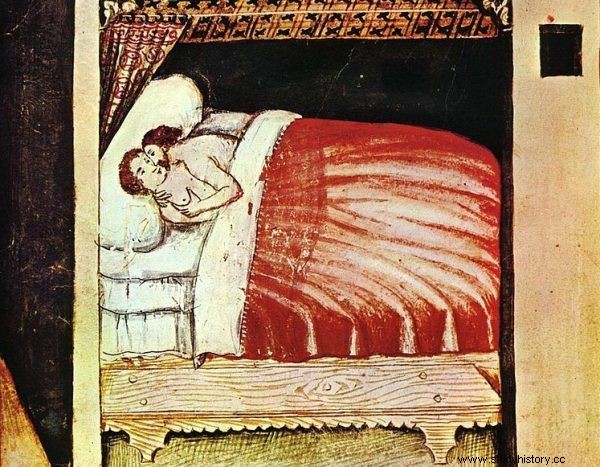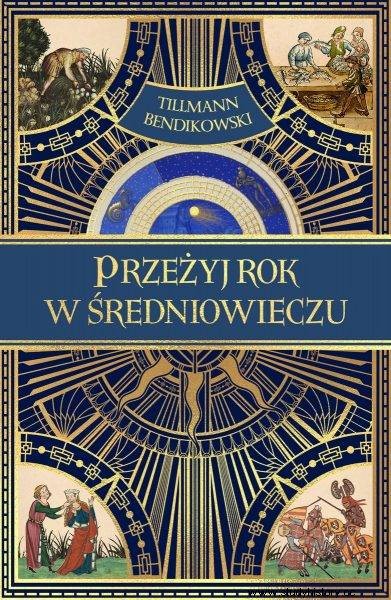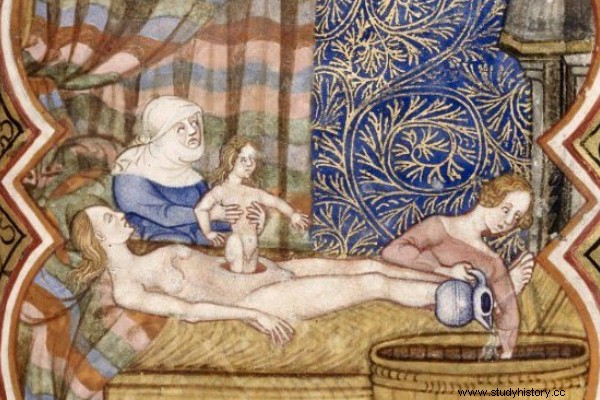Sex only in the dark (candles too expensive), only in the missionary position (the rest are sin) and only on days allowed by the church calendar (otherwise the devil's spawn will begin). And if God blesses and adds happiness, at least two will survive, including the longed-for son. What was marriage and family life like in the Middle Ages?
In the Middle Ages, the family was considered a microcosm of divine order, the realization of God's plan in a nutshell. It was necessary in due time, usually at the initiative of parents or guardians, to get married and beget children in a church-sanctified relationship.

What were marital duties and family life like in the Middle Ages?
In accordance with the provisions of the Council of Paris in 829, the sacrament of marriage was instituted by God and was to be received not to satisfy one's desire but to have children. Tillman Bendikowski in the book Experience a year in the Middle Ages writes:
Regardless of whether the mother of the mother is singing by the chosen one of her heart, or maybe her father promised her hand to her neighbor as a child - everywhere, from the royal court to a peasant farm, the same is expected of the spouse:she is to bear children.
What was to be done in order to get offspring quickly?
Do not take the wives in the "dog's way"
First of all, the spouses should know what and when should and should not be practiced in the bed room. Sex was to be practiced only in the classical position, pleasing to God and enabling a child to be conceived quickly. Any other position was considered either unfavorable to conception (e.g. the spoon position was supposed to facilitate the flow of sperm from the woman's body) or unworthy (e.g. the position from the back which Burchard of Worms warned against in Book XIX of Liber Decretorum , making each husband fasting for a wife "doggy style").
Rider sex was also forbidden - it was argued that this was how Adam's first wife, Lilith, wanted to make love, for which God had driven her out of paradise. As you can easily guess, oral sex, anal sex, and masturbation were also condemned, and any sex practices contrary to God's order were threatened with severe penance. As St. Augustine, who himself had a lot of experience in this matter from his youth:
Intercourse against nature, dishonorable in a woman of indecency, in a wife is even more contempt [...]. And when the husband wishes to use a female organ not intended for that use, the wife acts more disgracefully by allowing it than if she agreed to do so with another woman.

First of all, the spouses should know what and when should and should not be practiced in the bed room. Sex should only be practiced in the classical position as pleasing to God and enabling a child to conceive quickly.
If that wasn't enough, sex could only be in accordance with the church calendar, so on Sundays, holidays, and fasting periods, you shouldn't even think about playing games. As described in his chronicle by Thietmar, the ban on intercourse on Good Friday was broken by King Henry I the Birdman, who was mad with passion for his second wife, Matilda. When a woman became pregnant, a devil's spawn was to be born, but the sacrament of baptism wiped out Hell's authority over the child.
There was also a categorical ban on intercourse during menstruation and during pregnancy, which was warned by, inter alia, st. Augustyn, Wojciech Jastrzębiec and Stanisław of Skarbimierz. It was believed that a child conceived during menstruation would be a monster or a cripple.
It was necessary to wait until the end of the era for marital sex to be rehabilitated. In the thirteenth century, Albert the Great explained in Sum theologie that "there is no sin in marriage."
A hundred years later, an outstanding representative of the Krakow intellectual elite, theologian, philosopher and preacher, one of the reformers of the Jagiellonian University, Mateusz from Krakow, appreciated the role of sensual pleasure. He expressed a shocking view to many at the time that many people would not want to start a family or raise children if it were not for physical pleasure. Moreover, he concluded that an attractive wife is by no means misleading her husband astray, but rather distracting him from the sinful and wicked life to which singles and lighthearted men are more exposed.
Saints and healing waters for fertility
Fertility was one of the greatest female virtues in the Middle Ages. Those who could not get offspring were often scorned, and husbands kept them apart. Having many children was a proof of divine grace and a reward for a godly life.
As Tillman Bendikowski emphasizes, if the relationship was childless, the wife was solely to blame. To erase it, she should have gone on a pilgrimage, made offerings, or prayed to a suitable saint or saint.
In Gallus Anonymus we read about the unhappy, long barren marriage of Władysław Herman and Judith, who prayed earnestly and fasted, gave alms, but God did not want to bless their son for almost five years. Bishop Franco advised them to turn to a certain "infallible" Saint Giles on these matters.

The text was created, among others based on the book by Tillmann Bendikowski "Experience the Year in the Middle Ages", which has just been published by the Znak Horyzont publishing house.
The princely couple ordered a golden statue of the size of a child to be made and gifts to be delivered by trusted envoys to the convent of Saint-Gilles in Provence along with a letter asking for intercession. The monks from the monastery began fasting for the princes, but even before the envoys had time to return to Poland, the duchess was already carrying a successor under her heart - the future Bolesław the Wrymouth. Tillman Bendikowski reports:
It often happens that the spouses of ruling nobles go through terrible years of anxiety and anticipation, lamenting themselves and their bodies, believing that they have been possessed by the devil and demons , they pray and confess, do penance and sing pious songs, just to give birth to a child, preferably a boy . Since the continuity of the dynasty is extremely important, this period of eagerly awaiting offspring is a terrible experience for the whole family.
An alternative to praying for the intention of conceiving a descendant was to use the help of astrology and secret sciences, folk or traditional medicine. Queen Jadwiga Andegaweńska, who for 12 years of marriage with Władysław Jagiełło could not wait for an heir, went to the Norbertine Sisters in Busko, where, according to the recommendation of Bishop Jan Radlica, her confidant and medic, she took a bath in rich in bromine, iodine, iron and hydrogen sulphide, as well as waters enriched with fertility-enhancing herbs.
The Queen did become pregnant, but died shortly after giving birth. The daughter, Elżbieta Bonifacja, did not survive even a month. Interestingly, if you believe the medical treatises of the time, the conception of a daughter testified to the weakness of the father's sperm, although the mother was blamed for the "wrong" sex of the child anyway . As we read in Bendikowski:
When the wife finally gives birth to a child, the father's happiness becomes even greater when a boy is born. At least this is the case in noble families, because the child's sex depends on the inheritance of family property, from which girls are usually excluded.

The Queen did become pregnant, but died shortly after giving birth. The daughter, Elżbieta Bonifacja, did not survive even a month.
As we know, many years later Jagiełło, who in the meantime had another daughter, had three sons with Zofia Holszańska, his fourth wife. The youngest of them, the future king, Kazimierz Jagiellończyk, could pride himself on the paternity of thirteen children, 11 of whom lived to adulthood.
His wife, Elżbieta Rakuszanka, was one of the "exemplary" Polish queens in terms of fertility, for which she was nicknamed "Mother of Kings". This is an extraordinary achievement, considering the fact that the Queen was sickly in her childhood, suffered from malnutrition, and in her adult life she had, among others, deformed spine due to childhood bone tuberculosis.
Pores and stones for easy labor
It is a truism to say that childbirth in the Middle Ages was associated with a great threat to life for both the mother and the child. Two centuries after the death of Queen Jadwiga in childbirth, a certain Izentruda, Bertold's wife from Wrocław, terrified by the vision of death, prayed for the intercession of St. Jadwiga, when around the 10th week of pregnancy, still could not sense the fetal movements. She watched at the saint's tomb until the child began to move and a healthy daughter was finally born.
We do not know if Izentruda was wealthy enough to be able to count on the help of a qualified physician, moreover, the state of medical knowledge was insufficient to deal with complicated cases. If the delivery was difficult or prolonged and a medic was called to the woman in labor, he could, for example, ask if the pregnant woman ate a bow (leeks). And if not, don't be surprised that this is how the childbirth proceeds, after all, the Salernitan school clearly recommended:"Which of the ladies, indeed, and the bows advises, in giving birth each year will not be a defect."

It is a truism to say that childbirth in the Middle Ages was associated with a great threat to life for both the mother and the child.
In addition, instead of giving birth, he looked at the stool on which the childbirth was taking place, and ... put an eagle stone under it. It is said that the stone that the eagle brought its female to lay eggs lightly was reliable in dealing with obstetric complications.
It was different when it comes to keeping the newborn baby and his mother alive - sometimes both of them must have seemed like a miracle to survive. Adding to this a number of external factors, such as natural disasters and plagues, we gain a slightly smaller image than it might seem, of a medieval family.
Usually it was made up of parents and two or three children, except for three-generation families. So where does the myth about the huge fertility of people of the Middle Ages come from? Well, contrary to what we may think today, these were not the "dark ages" at all, for example, methods of preventing conception were known and used in marriages as well. But that's a topic for a completely different article.
Literature:
- Tillmann Bendikowski, "Experience the year in the Middle Ages", Krakow 2021.
- Bukowczan-Rzeszut, A., How to survive in medieval Krakow , Krakow 2017.
- Żoładź-Strzelczyk, D., A Child in Old Poland , Poznań 2006.
- The Chronicle of Thietmar . tr. Marian Zygmunt Jedlicki, MP Krzysztof Ożóg, Krakow 2014.
- Saint Augustine's Scriptures on Marriage and Virginity , ed. A. Eckmann, Lublin 2003.
- Krawiec, A., Sexuality in the Middle Ages , Poznań 2000.
